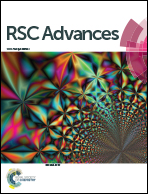A new type of triphenylamine based coumarin–rhodamine hybrid compound: synthesis, photophysical properties, viscosity sensitivity and energy transfer†
Abstract
A series of novel core modified triphenylamine coumarin–rhodamine systems (compounds MCMR, MCDR and DCMR) was designed and synthesized by incorporating a coumarin moiety on one and a rhodamine moiety on the other phenyl ring of the triphenylamine molecular skeleton. The resulting dyes possessed the individual advantages of coumarin and rhodamine derivatives to show high fluorescence in their spirocyclic and open form respectively. Positive solvatochromism observed in the spirocyclic form is well supported by a linear (Lippert–Mataga and Mac-Rae) and a multi-linear regression analysis (Kamlet–Taft and Catalan parameters) suggesting that for all three compounds solvent polarizability and solvent dipolarity are the main factors responsible for their slightly red shifted absorption spectra, and highly red shifted emission spectra. The viscosity studies are indicative of the induced fluorescence enhancement of open form rhodamine derivatives over the viscosity insensitive rigid lactone ring of spirocyclic form of rhodamine derivatives. In the present studies compound MCMR in its open form when excited at 440 nm shows through space energy transfer from coumarin donor to rhodamine acceptor. This design strategy is straightforward and adaptable to various deep red dyes by simply modifying the core of different fluorophores, thereby generating a through space energy transfer systems.



 Please wait while we load your content...
Please wait while we load your content...